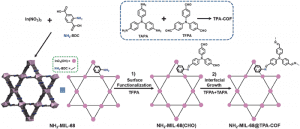Metal-organic frameworks (MOFs) are a class of porous crystalline materials, consisting of metal ions or clusters coordinated to organic ligands. Similarly, covalent organic frameworks (COFs) are also porous crystalline materials, in which building blocks are linked by covalent bonds and are made entirely from light elements (e.g., H, B, C, N, and O). Both MOFs and COFs are receiving increasing research attention in the recent years, owing to their large surface area, tunable pore architectures, and promising diverse functionalities. Several MOFs or COFs-based hybrid materials have been reported, but the integration of these two kinds of materials together has remained challenging and unexplored.
In their recent communication in Advanced Materials, Hua Zhang and his colleagues at Nanyang Technological University present an elegant strategy to synthesize a novel MOF@COF core-shell hybrid material (NH2-MIL-68@TPA-COF), and the surface functionalization of NH2-MIL-68 is a prerequisite for the success. Moreover, this strategy can also be used to synthesize other MOF@COF hybrid materials (such as MIL-69@TPA-COF). This novel class of porous hybrid material features high crystallinity and hierarchical pore structure with multi-functionality. As a proof-of-concept application, the prepared NH2-MIL-68@TPA-COF is used as an effective photocatalyst for the degradation of rhodamine B under visible light irradiation, which is shown to be around 1.4 times faster than that of unmodified NH2-MIL-68. This enhanced photocatalytic activity could be attributed to its larger surface area together with the smaller band gap compared to the MOF only.
The authors believe that the strategy presented here might open an avenue toward the construction of other MOF-COF hybrid materials, which could have various promising applications in the degradation of pollutants, separation of materials, heterogeneous catalysis, and electronic devices.


















